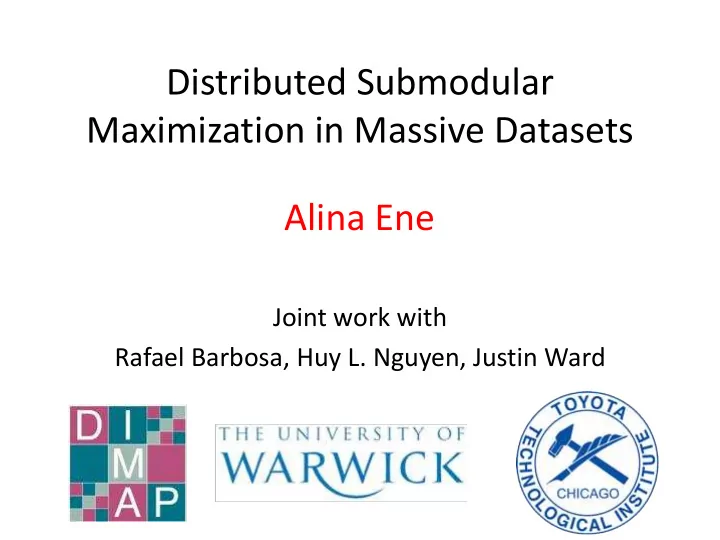

Distributed Submodular Maximization in Massive Datasets Alina Ene Joint work with Rafael Barbosa, Huy L. Nguyen, Justin Ward
Combinatorial Optimization • Given – A set of objects V – A function f on subsets of V – A collection of feasible subsets I • Find – A feasible subset of I that maximizes f • Goal – Abstract/general f and I – Capture many interesting problems – Allow for efficient algorithms
Submodularity We say that a function is submodular if: We say that is monotone if: Alternatively, f is submodular if: for all and Submodularity captures diminishing returns.
Submodularity Examples of submodular functions: – The number of elements covered by a collection of sets – Entropy of a set of random variables – The capacity of a cut in a directed or undirected graph – Rank of a set of columns of a matrix – Matroid rank functions – Log determinant of a submatrix
Example: Multimode Sensor Coverage • We have distinct locations where we can place sensors • Each sensor can operate in different modes, each with a distinct coverage profile • Find sensor locations, each with a single mode to maximize coverage
Example: Identifying Representatives In Massive Data
Example: Identifying Representative Images • We are given a huge set X of images. • Each image is stored multidimensional vector. • We have a function d giving the difference between two images. • We want to pick a set S of at most k images to minimize the loss function: • Suppose we choose a distinguished vector e 0 (e.g. 0 vector), and set: • The function f is submodular. Our problem is then equivalent to maximizing f under a single cardinality constraint.
Need for Parallelization • Datasets grow very large – TinyImages has 80M images – Kosarak has 990K sets • Need multiple machines to fit the dataset • Use parallel frameworks such as MapReduce
Problem Definition • Given set V and submodular function f • Hereditary constraint I (cardinality at most k, matroid constraint of rank k, … ) • Find a subset that satisfies I and maximizes f • Parameters – n = |V| – k : max size of feasible solutions – m : number of machines
Greedy Algorithm Initialize S = {} While there is some element x that can be added to S: Add to S the element x that maximizes the marginal gain Return S
Greedy Algorithm • Approximation Guarantee: • 1 - 1/e for a cardinality constraint • 1/2 for a matroid constraint • Runtime: O(nk) • Need to recompute marginals each time an element is added • Not good for large data sets
Mirzasoleiman, Karbasi, Sarkar, Krause '13 Distributed Greedy
Mirzasoleiman, Karbasi, Sarkar, Krause '13 Performance of Distributed Greedy • Only requires 2 rounds of communication • Approximation ratio is: (where m is number of machines) • If we use the optimal algorithm on each machine in both phases, we can still only get:
Performance of Distributed Greedy • If we use the optimal algorithm on each machine in both phases, we can still only get: • In fact, we can show that using greedy gives: • Why? – The problem doesn't have optimal substructure. – Better to run greedy in round 1 instead of the optimal algorithm.
Revisiting the Analysis • Can construct bad examples for Greedy/optimal • Lower bound for any poly(k) coresets (Indyk et al. ’14) • Yet the distributed greedy algorithm works very well on real instances • Why?
Power of Randomness • Randomized distributed Greedy – Distribute the elements of V randomly in round 1 – Select the best solution found in rounds 1 & 2 • Theorem: If Greedy achieves a C approximation, randomized distributed Greedy achieves a C/2 approximation in expectation.
Intuition • If elements in OPT are selected in round 1 with high probability – Most of OPT is present in round 2 so solution in round 2 is good • If elements in OPT are selected in round 1 with low probability – OPT is not very different from typical solution so solution in round 1 is good
Analysis (Preliminaries) • Greedy Property: – Suppose: • x is not selected by greedy on S ∪ {x} • y is not selected by greedy on S ∪ {y} – Then: • x and y are not selected by greedy on S ∪ {x,y} • Lovasz extension : convex function on [0,1] V that agrees with on integral vectors.
Analysis (Sketch) • Let X be a random 1/m sample of V • For e in OPT, let p e be the probability (over choice of X) that e is selected by Greedy on X ∪ {e} • Then, expected value of elements of OPT on the final machine is • On the other hand, expected value of rejected elements is
Analysis (Sketch) The final greedy solution T satisfies: The best single machine solution S satisfies: Altogether, we get an approximation in expectation of:
Generality • What do we need for the proof? – Monotonicity and submodularity of f – Heredity of constraint – Greedy property • The result holds in general any time greedy is an -approximation for a hereditary, constrained submodular maximization problem.
Non-monotone Functions • In the first round, use Greedy on each machine • In the second round, use any algorithm on the last machine • We still obtain a constant factor approximation for most problems
Tiny Image Experiments (n = 1M, m = 100)
Matroid Coverage Experiments Matroid Coverage (n=100, r=100) Matroid Coverage (n=900, r=5) It's better to distribute ellipses from each location across several machines!
Future Directions • Can we relax the greedy property further? • What about non-greedy algorithms? • Can we speed up the final round, or reduce the number machines required? • Better approximation guarantees?
Recommend
More recommend